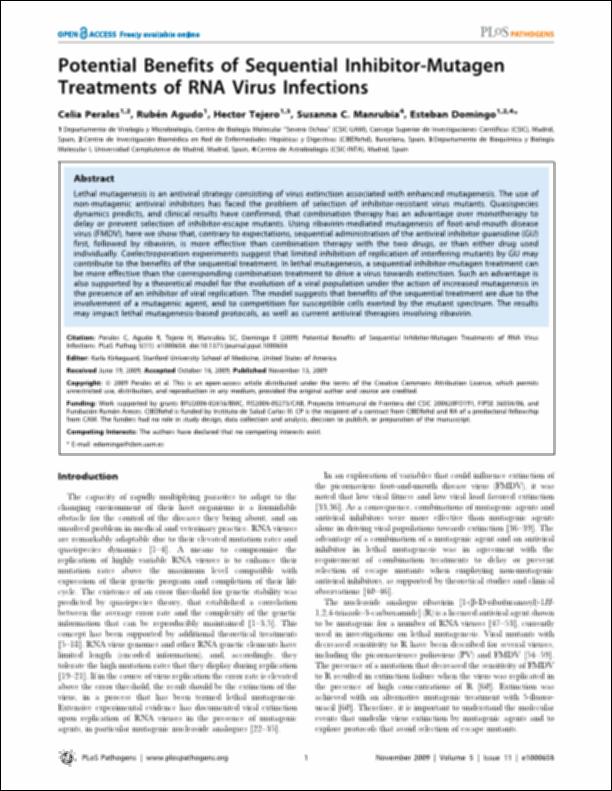Por favor, use este identificador para citar o enlazar este ítem:
http://hdl.handle.net/10637/15653Potential Benefits of Sequential Inhibitor-Mutagen Treatments of RNA Virus Infections
| Título : | Potential Benefits of Sequential Inhibitor-Mutagen Treatments of RNA Virus Infections |
| Autor : | Perales, Celia Agudo Torres, Rubén Tejero Franco, Héctor Manrubia, Susanna C. Domingo, Esteban |
| Materias: | Sequential Inhibitor-Mutagen Treatments; RNA Virus Infections; Ribavirin |
| Editorial : | Public Library of Science |
| Citación : | Perales C, Agudo R, Tejero H, Manrubia SC, Domingo E (2009) Potential Benefits of Sequential Inhibitor-Mutagen Treatments of RNA Virus Infections. PLoS Pathog 5(11): e1000658. doi:10.1371/journal.ppat.1000658 |
| Resumen : | Lethal mutagenesis is an antiviral strategy consisting of virus extinction associated with enhanced mutagenesis. The use of non-mutagenic antiviral inhibitors has faced the problem of selection of inhibitor-resistant virus mutants. Quasispecies dynamics predicts, and clinical results have confirmed, that combination therapy has an advantage over monotherapy to delay or prevent selection of inhibitor-escape mutants. Using ribavirin-mediated mutagenesis of foot-and-mouth disease virus (FMDV), here we show that, contrary to expectations, sequential administration of the antiviral inhibitor guanidine (GU) first, followed by ribavirin, is more effective than combination therapy with the two drugs, or than either drug used individually. Coelectroporation experiments suggest that limited inhibition of replication of interfering mutants by GU may contribute to the benefits of the sequential treatment. In lethal mutagenesis, a sequential inhibitor-mutagen treatment can be more effective than the corresponding combination treatment to drive a virus towards extinction. Such an advantage is also supported by a theoretical model for the evolution of a viral population under the action of increased mutagenesis in the presence of an inhibitor of viral replication. The model suggests that benefits of the sequential treatment are due to the involvement of a mutagenic agent, and to competition for susceptible cells exerted by the mutant spectrum. The results may impact lethal mutagenesis-based protocols, as well as current antiviral therapies involving ribavirin. |
| URI : | http://hdl.handle.net/10637/15653 |
| Derechos: | http://creativecommons.org/licenses/by-nc-nd/4.0/deed.es OpenAccess |
| ISSN : | 1553-7374 |
| Fecha de publicación : | 13-nov-2009 |
| Aparece en las colecciones: | Facultad de Farmacia |
Los ítems de DSpace están protegidos por copyright, con todos los derechos reservados, a menos que se indique lo contrario.


